AMD’s 5 GHz Turbo CPU in Retail: The FX-9590 and ASRock 990FX Extreme9 Review
by Ian Cutress on August 9, 2014 8:00 AM ESTCPU Benchmarks: Comparing Motherboards
Readers of our motherboard review section will have noted the trend in modern motherboards to implement a form of MultiCore Enhancement / Acceleration / Turbo (read our report here) on their motherboards. This does several things – better benchmark results at stock settings (not entirely needed if overclocking is an end-user goal), at the expense of heat and temperature, but also gives in essence an automatic overclock which may be against what the user wants. Our testing methodology is ‘out-of-the-box’, with the latest public BIOS installed and XMP enabled, and thus subject to the whims of this feature. It is ultimately up to the motherboard manufacturer to take this risk – and manufacturers taking risks in the setup is something they do on every product (think C-state settings, USB priority, DPC Latency / monitoring priority, memory subtimings at JEDEC). Processor speed change is part of that risk which is clearly visible, and ultimately if no overclocking is planned, some motherboards will affect how fast that shiny new processor goes and can be an important factor in the purchase.
Point Calculations – 3D Movement Algorithm Test: link
3DPM is a self-penned benchmark, taking basic 3D movement algorithms used in Brownian Motion simulations and testing them for speed. High floating point performance, MHz and IPC wins in the single thread version, whereas the multithread version has to handle the threads and loves more cores.
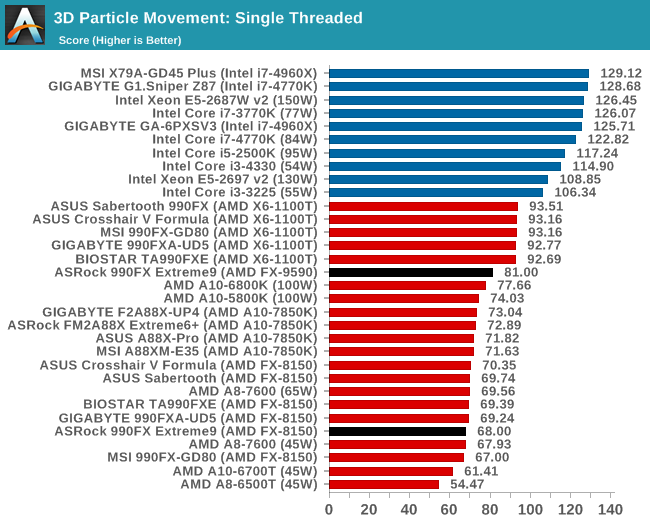

Compression – WinRAR 5.0.1: link
Our WinRAR test from 2013 is updated to the latest version of WinRAR at the start of 2014. We compress a set of 2867 files across 320 folders totaling 1.52 GB in size – 95% of these files are small typical website files, and the rest (90% of the size) are small 30 second 720p videos.
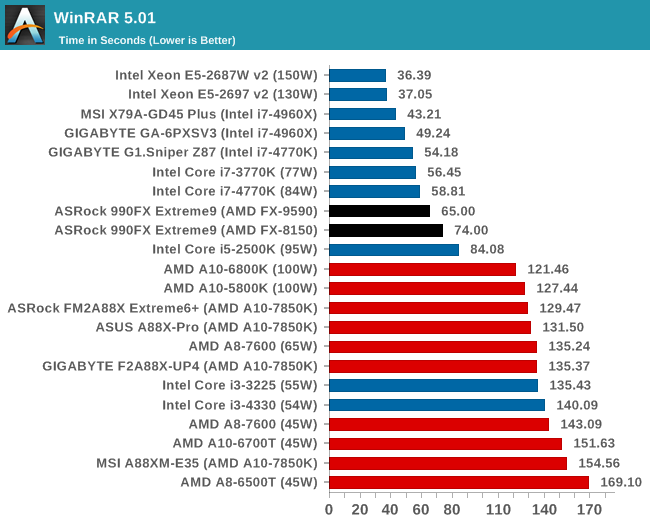
Image Manipulation – FastStone Image Viewer 4.9: link
FastStone is the program I use to perform quick or bulk actions on images, such as resizing, adjusting for color and cropping. In our test we take a series of 170 images in various sizes and formats and convert them all into 640x480 .gif files, maintaining the aspect ratio. FastStone does not use multithreading for this test, and results are given in seconds.
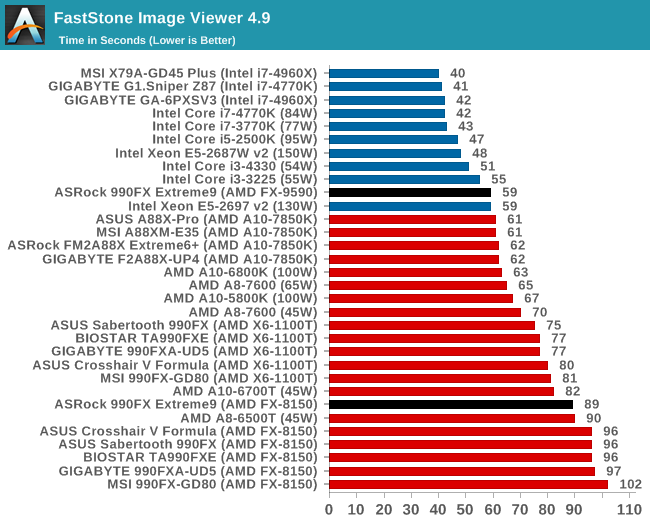
The FX-8150 result for the Extreme9 compared to other motherboards shows one of two things - the latest Windows SP1 with core parking updates has an effect, or the BIOS is more efficient at handling turbo modes than our older reviews.
Video Conversion – Handbrake v0.9.9: link
For HandBrake, we take two videos (a 2h20 640x266 DVD rip and a 10min double UHD 3840x4320 animation short) and convert them to x264 format in an MP4 container. Results are given in terms of the frames per second processed, and HandBrake uses as many threads as possible.
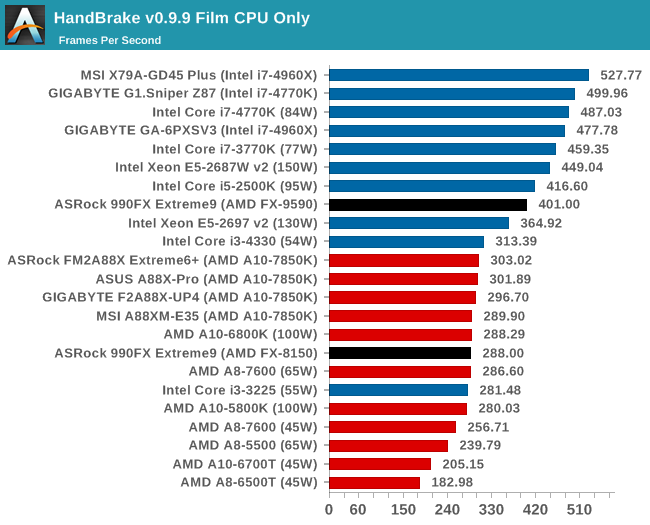

Rendering – PovRay 3.7: link
The Persistence of Vision RayTracer, or PovRay, is a freeware package for as the name suggests, ray tracing. It is a pure renderer, rather than modeling software, but the latest beta version contains a handy benchmark for stressing all processing threads on a platform. We have been using this test in motherboard reviews to test memory stability at various CPU speeds to good effect – if it passes the test, the IMC in the CPU is stable for a given CPU speed. As a CPU test, it runs for approximately 2-3 minutes on high end platforms.
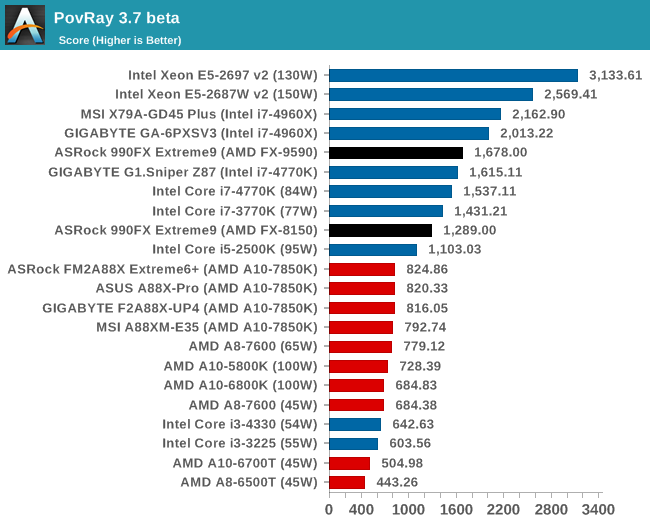
Synthetic – 7-Zip 9.2: link
As an open source compression tool, 7-Zip is a popular tool for making sets of files easier to handle and transfer. The software offers up its own benchmark, to which we report the result.
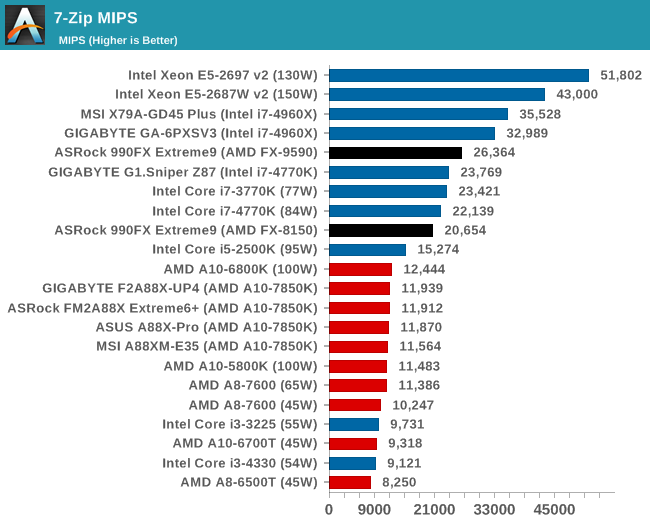










146 Comments
View All Comments
RussianSensation - Sunday, August 10, 2014 - link
The motherboard in the review is $170 not $250. But yes it's a lot better to buy an i5-7 than this chip.edwd2 - Saturday, August 9, 2014 - link
Will we be getting new FX chips in the future?or is it just APUs ...
Mrduder11 - Saturday, August 9, 2014 - link
I am not highly invested in either "camp" but I will say this is absolutely embarrassing for AMD. As a gamer, I could never justify purchasing this CPU when using with a dedicated graphics setup. The results show AMD's way off the mark in research and development in their GPU labs.RussianSensation - Sunday, August 10, 2014 - link
Has little to do with research and development. You can't expect a 28-32nm CPU to compete with a 22nm CPU no matter how hard you try. It would be akin to NV having 28nm GTX780Ti going up against a 40nm HD6970. AMD's biggest problem is no access to the same lithography tech as Intel.mapesdhs - Tuesday, August 12, 2014 - link
Actually it has a lot to do with R&D. An ex-AMD employee said a few years ago thatAMD's big mistake was making extensive use of automated design tools, resulting
in a 3rd more transistors, using more power, for less performance. Presumably this
was cheaper than paying the required talent to do the fine tuning normally expected
at this level. Either way, this is why BD was so bad, and they've never recovered.
AMD simply doesn't have the money to do the base R&D, that's the key blockage.
Ian.
Budburnicus - Wednesday, January 14, 2015 - link
Umm, the i5-2500k AND i7-2600K are 32nm CPU's and even at a 4.7 GHz overclock do not even draw HALF the power and are over TWICE as fast! All from a 3 year old SKU!The cherry on top of the pile of dog poop would HAVE to be the fact that AMD had to make an R9 290 with a 512 bit memory bus to TRY to keep up with Nvidia's 970 or 980 - and that GPU takes over twice the power as well!
So YES this has EVERYTHING to do with R&D! Both their CPUs and GPUs are HORRIBLY inefficient!
And again, process has little to do with it, bearing in mind that the 32nm i-cores are not only 3 years old, but draw well less than HALF the power, and still over 1/3 less at the same 4.7 GHz clock speed, except when an i7-2600K is running at that speed, it is FAR FASTER in EVERY way!
TeXWiller - Saturday, August 9, 2014 - link
Who knows, Kaveri brought the three module support for the APUs. The devil is the implementation details and timing. I was little disappointed when they took out the remaining 95W four module chips from the channel.TiGr1982 - Saturday, August 9, 2014 - link
What do you mean by "three module support for the APUs"? Talking about CPU side of things, all the APUs since Trinity only have 2 CPU modules aka 4 AMD cores. More than that, staying with this Bulldozer-derived CPU tech, APUs won't get more than 2 modules because of the die area and associated TDP and cost issues.TeXWiller - Saturday, August 9, 2014 - link
See http://support.amd.com/TechDocs/49125_15h_Models_3... page 28TiGr1982 - Saturday, August 9, 2014 - link
OK,"2 or 3 core-pairs Add 3 CU support."
But there is no 3 "core-pair" (3 CU, 3 modules) Kaveri APUs on the market - at least, as of yet.